Nicholas P. Cheremisinoff. Handbook of Solid Waste Management and Waste Minimization Technologies
Подождите немного. Документ загружается.

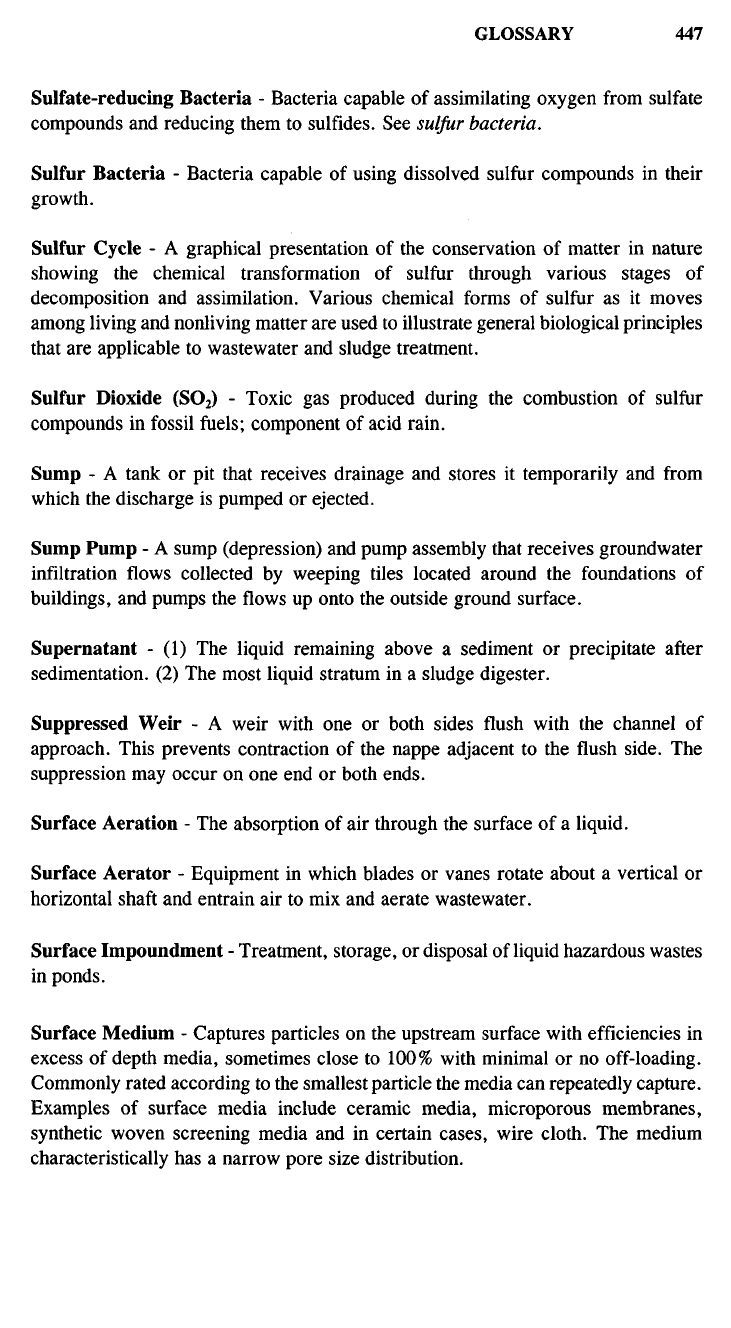
Sulfate-reducing Bacteria - Bacteria capable of assimilating oxygen from sulfate
compounds and reducing them to sulfides. See sulfur bacteria.
Sulfur Bacteria - Bacteria capable of using dissolved sulfur compounds in their
growth.
Sulfur Cycle - A graphical presentation of the conservation of matter in nature
showing the chemical transformation of sulfur through various stages of
decomposition and assimilation. Various chemical forms of sulfur as it moves
among living and nonliving matter are used to illustrate general biological principles
that are applicable to waste water and sludge treatment.
Sulfur Dioxide (SO
2
) - Toxic gas produced during the combustion of sulfur
compounds in fossil fuels; component of acid rain.
Sump - A tank or pit that receives drainage and stores it temporarily and from
which the discharge is pumped or ejected.
Sump Pump - A sump (depression) and pump assembly that receives groundwater
infiltration flows collected by weeping tiles located around the foundations of
buildings, and pumps the flows up onto the outside ground surface.
Supernatant - (1) The liquid remaining above a sediment or precipitate after
sedimentation. (2) The most liquid stratum in a sludge digester.
Suppressed Weir - A weir with one or both sides flush with the channel of
approach. This prevents contraction of the nappe adjacent to the flush side. The
suppression may occur on one end or both ends.
Surface Aeration - The absorption of air through the surface of a liquid.
Surface Aerator - Equipment in which blades or vanes rotate about a vertical or
horizontal shaft and entrain air to mix and aerate wastewater.
Surface Impoundment - Treatment, storage, or disposal of liquid hazardous wastes
in ponds.
Surface Medium - Captures particles on the upstream surface with efficiencies in
excess of depth media, sometimes close to 100% with minimal or no off-loading.
Commonly rated according to the smallest particle the media can repeatedly capture.
Examples of surface media include ceramic media, microporous membranes,
synthetic woven screening media and in certain cases, wire cloth. The medium
characteristically has a narrow pore size distribution.
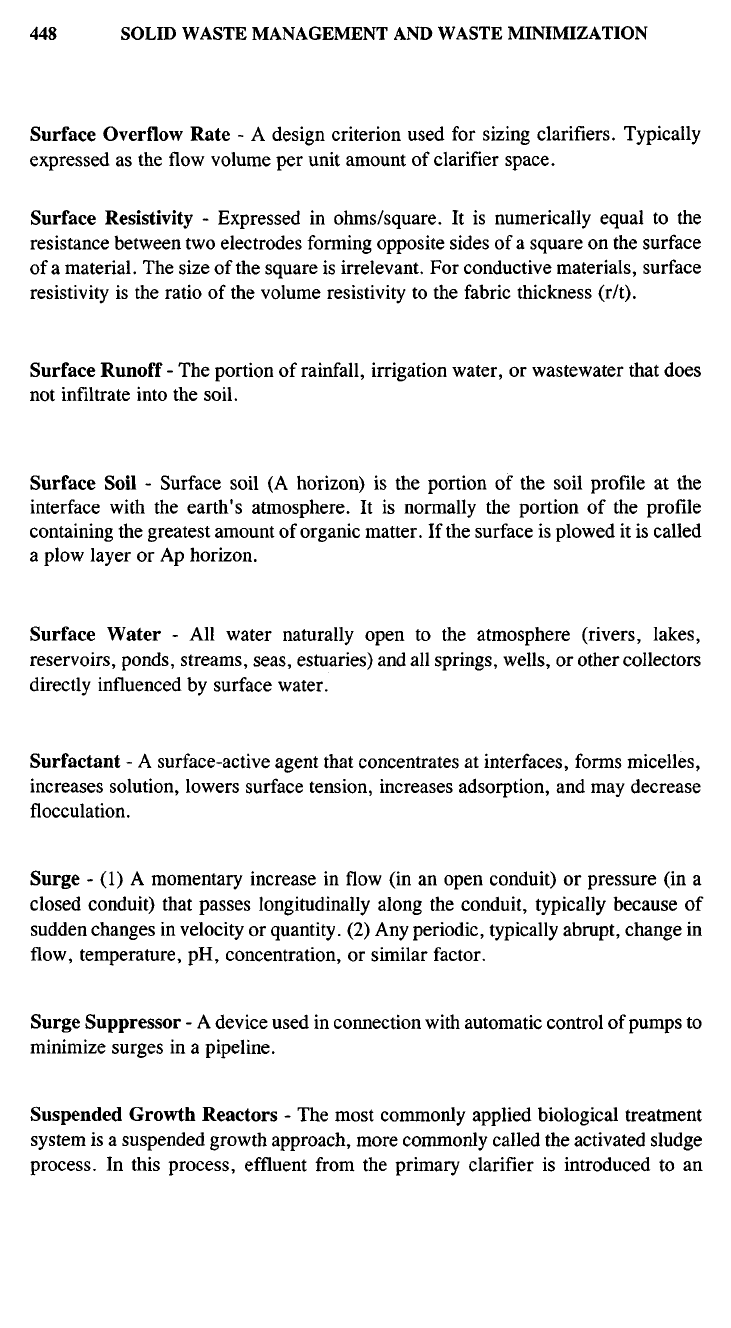
Surface Overflow Rate - A design criterion used for sizing clarifiers. Typically
expressed as the flow volume per unit amount of clarifier space.
Surface Resistivity - Expressed in ohms/square. It is numerically equal to the
resistance between two electrodes forming opposite sides of a square on the surface
of a material. The size of the square is irrelevant. For conductive materials, surface
resistivity is the ratio of the volume resistivity to the fabric thickness (r/t).
Surface Runoff - The portion of rainfall, irrigation water, or waste water that does
not infiltrate into the soil.
Surface Soil - Surface soil (A horizon) is the portion of the soil profile at the
interface with the earth's atmosphere. It is normally the portion of the profile
containing the greatest amount of organic matter. If the surface is plowed it is called
a plow layer or Ap horizon.
Surface Water - All water naturally open to the atmosphere (rivers, lakes,
reservoirs, ponds, streams, seas, estuaries) and all springs, wells, or other collectors
directly influenced by surface water.
Surfactant - A surface-active agent that concentrates at interfaces, forms micelles,
increases solution, lowers surface tension, increases adsorption, and may decrease
flocculation.
Surge - (1) A momentary increase in flow (in an open conduit) or pressure (in a
closed conduit) that passes longitudinally along the conduit, typically because of
sudden changes in velocity or quantity. (2) Any periodic, typically abrupt, change in
flow, temperature, pH, concentration, or similar factor.
Surge Suppressor - A device used in connection with automatic control of pumps to
minimize surges in a pipeline.
Suspended Growth Reactors - The most commonly applied biological treatment
system is a suspended growth approach, more commonly called the activated sludge
process. In this process, effluent from the primary clarifier is introduced to an
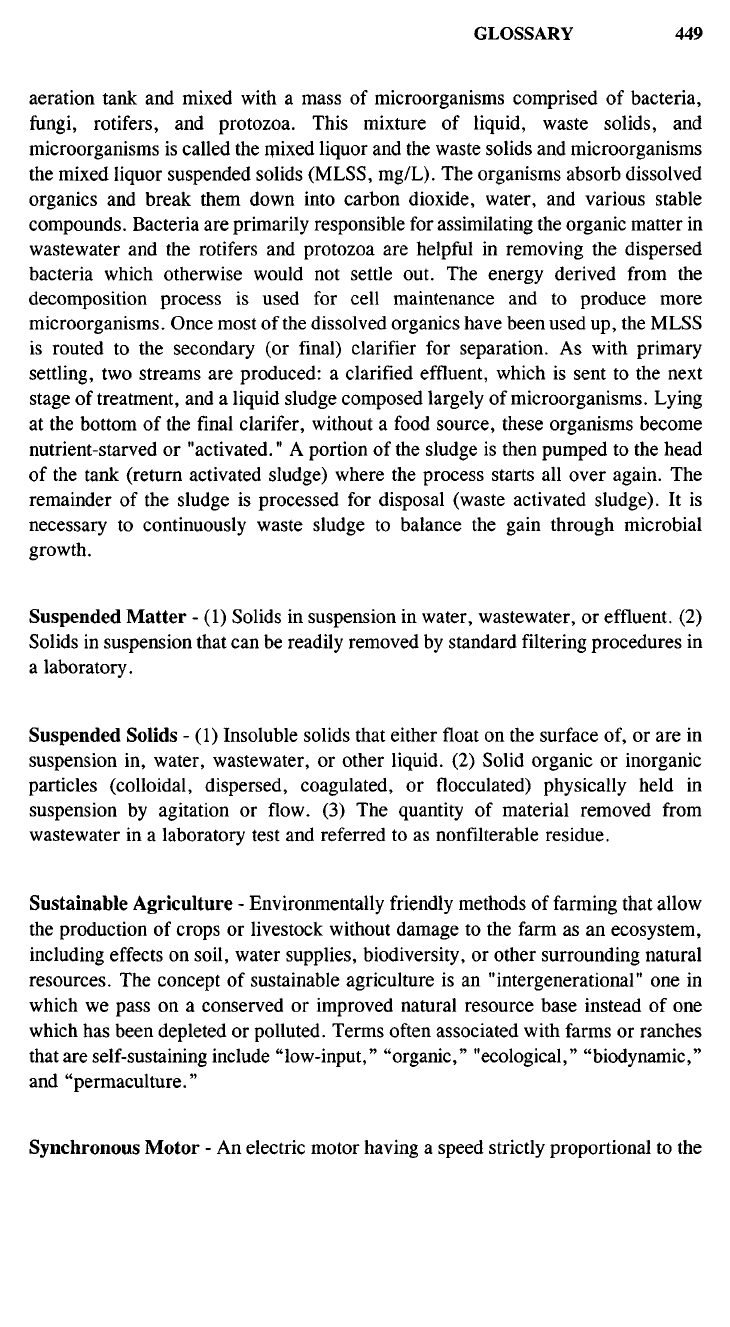
aeration tank and mixed with a mass of microorganisms comprised of bacteria,
fungi, rotifers, and protozoa. This mixture of liquid, waste solids, and
microorganisms is called the mixed liquor and the waste solids and microorganisms
the mixed liquor suspended solids (MLSS, mg/L). The organisms absorb dissolved
organics and break them down into carbon dioxide, water, and various stable
compounds. Bacteria are primarily responsible for assimilating the organic matter in
wastewater and the rotifers and protozoa are helpful in removing the dispersed
bacteria which otherwise would not settle out. The energy derived from the
decomposition process is used for cell maintenance and to produce more
microorganisms. Once most of the dissolved organics have been used up, the MLSS
is routed to the secondary (or final) clarifier for separation. As with primary
settling, two streams are produced: a clarified effluent, which is sent to the next
stage of treatment, and a liquid sludge composed largely of microorganisms. Lying
at the bottom of the final clarifer, without a food source, these organisms become
nutrient-starved or "activated." A portion of the sludge is then pumped to the head
of the tank (return activated sludge) where the process starts all over again. The
remainder of the sludge is processed for disposal (waste activated sludge). It is
necessary to continuously waste sludge to balance the gain through microbial
growth.
Suspended Matter - (1) Solids in suspension in water, wastewater, or effluent. (2)
Solids in suspension that can be readily removed by standard filtering procedures in
a laboratory.
Suspended Solids - (1) Insoluble solids that either float on the surface of, or are in
suspension in, water, wastewater, or other liquid. (2) Solid organic or inorganic
particles (colloidal, dispersed, coagulated, or flocculated) physically held in
suspension by agitation or flow. (3) The quantity of material removed from
wastewater in a laboratory test and referred to as nonfilterable residue.
Sustainable Agriculture - Environmentally friendly methods of farming that allow
the production of crops or livestock without damage to the farm as an ecosystem,
including effects on soil, water supplies, biodiversity, or other surrounding natural
resources. The concept of sustainable agriculture is an "intergenerational" one in
which we pass on a conserved or improved natural resource base instead of one
which has been depleted or polluted. Terms often associated with farms or ranches
that are self-sustaining include "low-input," "organic," "ecological," "biodynamic,"
and "permaculture."
Synchronous Motor - An electric motor having a speed strictly proportional to the
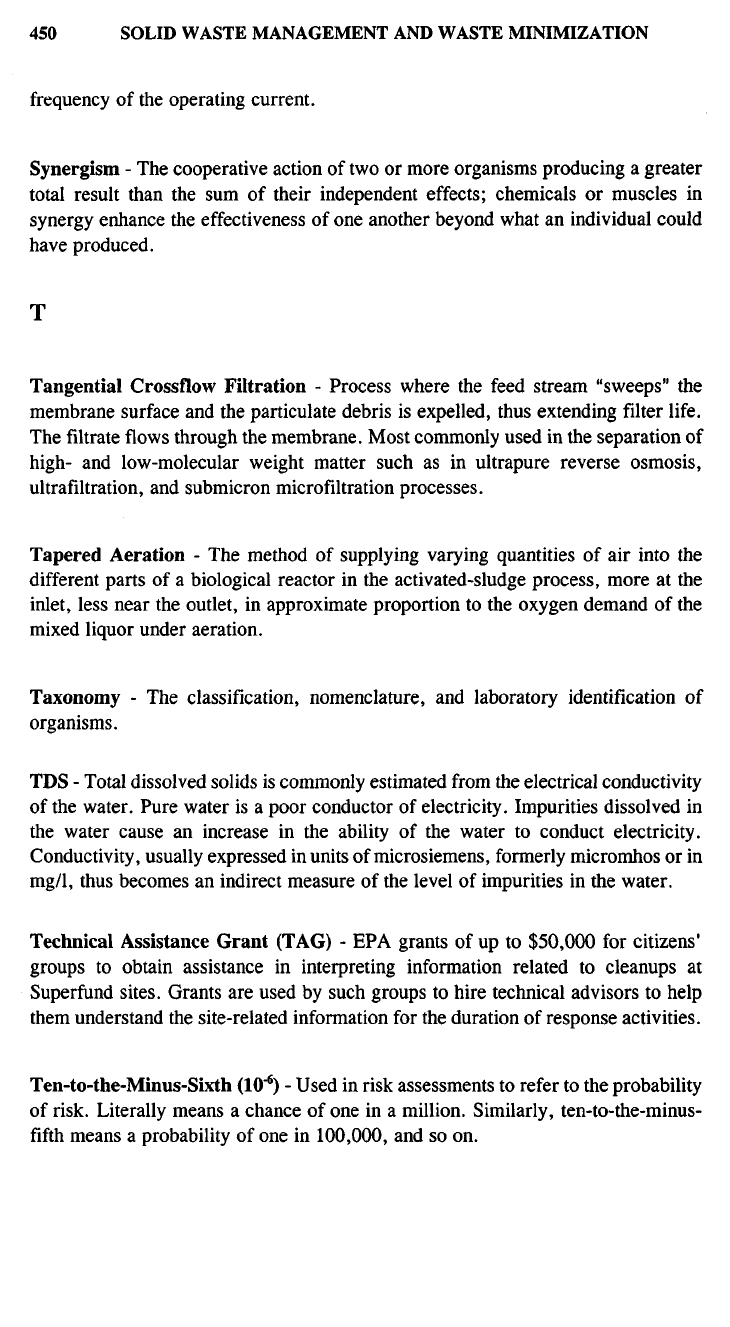
frequency of the operating current.
Synergism - The cooperative action of two or more organisms producing a greater
total result than the sum of their independent effects; chemicals or muscles in
synergy enhance the effectiveness of one another beyond what an individual could
have produced.
T
Tangential Crossflow Filtration - Process where the feed stream "sweeps" the
membrane surface and the paniculate debris is expelled, thus extending filter life.
The filtrate flows through the membrane. Most commonly used in the separation of
high- and low-molecular weight matter such as in ultrapure reverse osmosis,
ultrafiltration, and submicron microfiltration processes.
Tapered Aeration - The method of supplying varying quantities of air into the
different parts of a biological reactor in the activated-sludge process, more at the
inlet, less near the outlet, in approximate proportion to the oxygen demand of the
mixed liquor under aeration.
Taxonomy - The classification, nomenclature, and laboratory identification of
organisms.
TDS - Total dissolved solids is commonly estimated from the electrical conductivity
of the water. Pure water is a poor conductor of electricity. Impurities dissolved in
the water cause an increase in the ability of the water to conduct electricity.
Conductivity, usually expressed in units of microsiemens, formerly micromhos or in
mg/1,
thus becomes an indirect measure of the level of impurities in the water.
Technical Assistance Grant (TAG) - EPA grants of up to $50,000 for citizens'
groups to obtain assistance in interpreting information related to cleanups at
Superfund sites. Grants are used by such groups to hire technical advisors to help
them understand the site-related information for the duration of response activities.
Ten-to-the-Minus-Sixth (10
6
) - Used in risk assessments to refer to the probability
of risk. Literally means a chance of one in a million. Similarly, ten-to-the-minus-
fifth means a probability of one in 100,000, and so on.
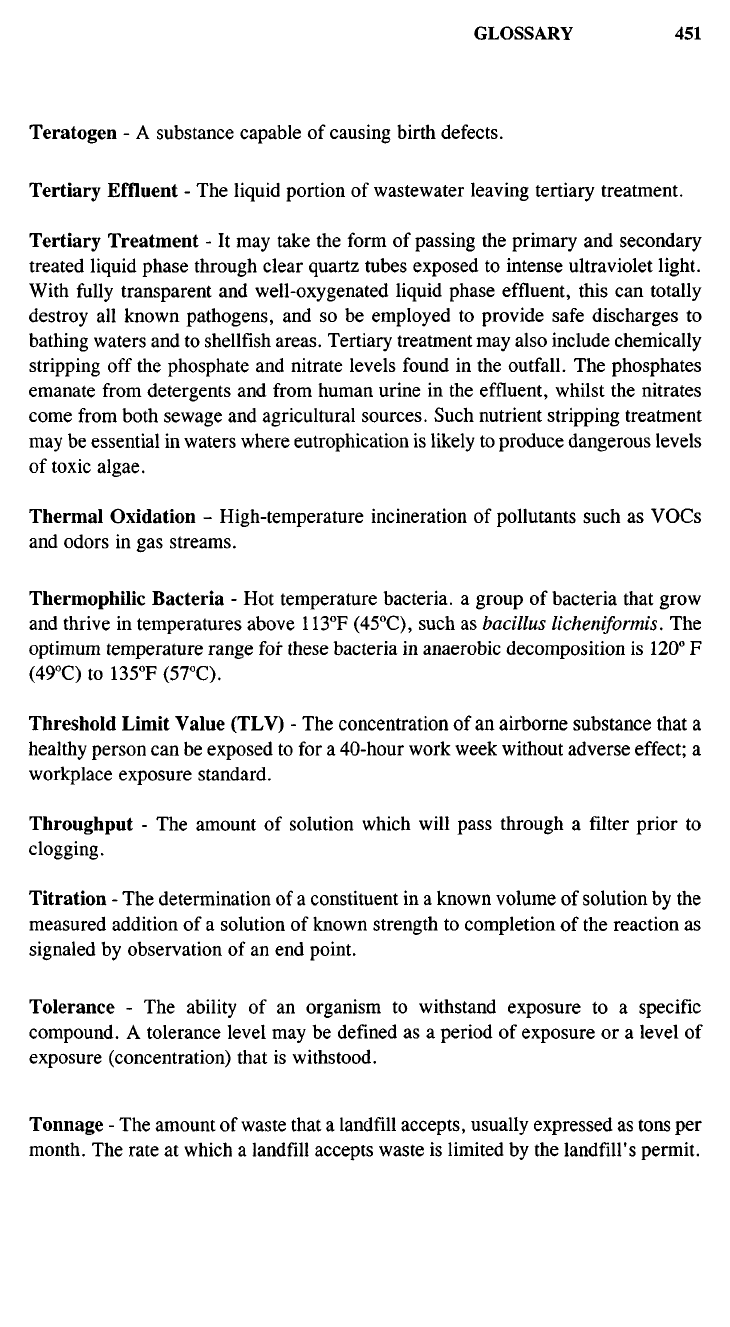
Teratogen - A substance capable of causing birth defects.
Tertiary Effluent - The liquid portion of wastewater leaving tertiary treatment.
Tertiary Treatment - It may take the form of passing the primary and secondary
treated liquid phase through clear quartz tubes exposed to intense ultraviolet light.
With fully transparent and well-oxygenated liquid phase effluent, this can totally
destroy all known pathogens, and so be employed to provide safe discharges to
bathing waters and to shellfish areas. Tertiary treatment may also include chemically
stripping off the phosphate and nitrate levels found in the outfall. The phosphates
emanate from detergents and from human urine in the effluent, whilst the nitrates
come from both sewage and agricultural sources. Such nutrient stripping treatment
may be essential in waters where eutrophication is likely to produce dangerous levels
of toxic algae.
Thermal Oxidation - High-temperature incineration of pollutants such as VOCs
and odors in gas streams.
Thermophilic Bacteria - Hot temperature bacteria, a group of bacteria that grow
and thrive in temperatures above 113
0
F (45
0
C), such as bacillus licheniformis. The
optimum temperature range for these bacteria in anaerobic decomposition is 120° F
(49
0
C) to 135
0
F (57
0
C).
Threshold Limit Value (TLV) - The concentration of an airborne substance that a
healthy person can be exposed to for a 40-hour work week without adverse effect; a
workplace exposure standard.
Throughput - The amount of solution which will pass through a filter prior to
clogging.
Titration - The determination of a constituent in a known volume of solution by the
measured addition of a solution of known strength to completion of the reaction as
signaled by observation of an end point.
Tolerance - The ability of an organism to withstand exposure to a specific
compound. A tolerance level may be defined as a period of exposure or a level of
exposure (concentration) that is withstood.
Tonnage - The amount of waste that a landfill accepts, usually expressed as tons per
month. The rate at which a landfill accepts waste is limited by the landfill's permit.
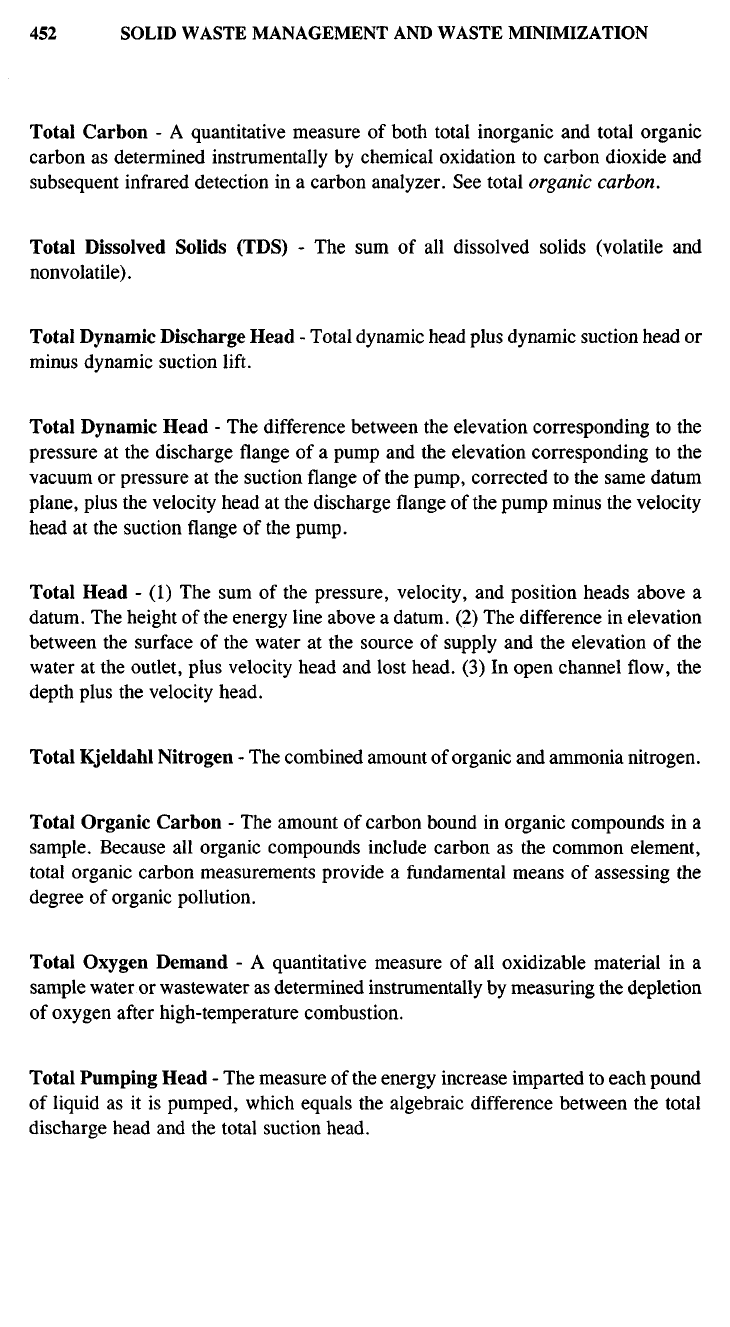
Total Carbon - A quantitative measure of both total inorganic and total organic
carbon as determined instrumentally by chemical oxidation to carbon dioxide and
subsequent infrared detection in a carbon analyzer. See total organic carbon.
Total Dissolved Solids (TDS) - The sum of all dissolved solids (volatile and
nonvolatile).
Total Dynamic Discharge Head - Total dynamic head plus dynamic suction head or
minus dynamic suction lift.
Total Dynamic Head - The difference between the elevation corresponding to the
pressure at the discharge flange of a pump and the elevation corresponding to the
vacuum or pressure at the suction flange of the pump, corrected to the same datum
plane, plus the velocity head at the discharge flange of the pump minus the velocity
head at the suction flange of the pump.
Total Head - (1) The sum of the pressure, velocity, and position heads above a
datum. The height of the energy line above a datum. (2) The difference in elevation
between the surface of the water at the source of supply and the elevation of the
water at the outlet, plus velocity head and lost head. (3) In open channel flow, the
depth plus the velocity head.
Total Kjeldahl Nitrogen - The combined amount of organic and ammonia nitrogen.
Total Organic Carbon - The amount of carbon bound in organic compounds in a
sample. Because all organic compounds include carbon as the common element,
total organic carbon measurements provide a fundamental means of assessing the
degree of organic pollution.
Total Oxygen Demand - A quantitative measure of all oxidizable material in a
sample water or wastewater as determined instrumentally by measuring the depletion
of oxygen after high-temperature combustion.
Total Pumping Head - The measure of the energy increase imparted to each pound
of liquid as it is pumped, which equals the algebraic difference between the total
discharge head and the total suction head.
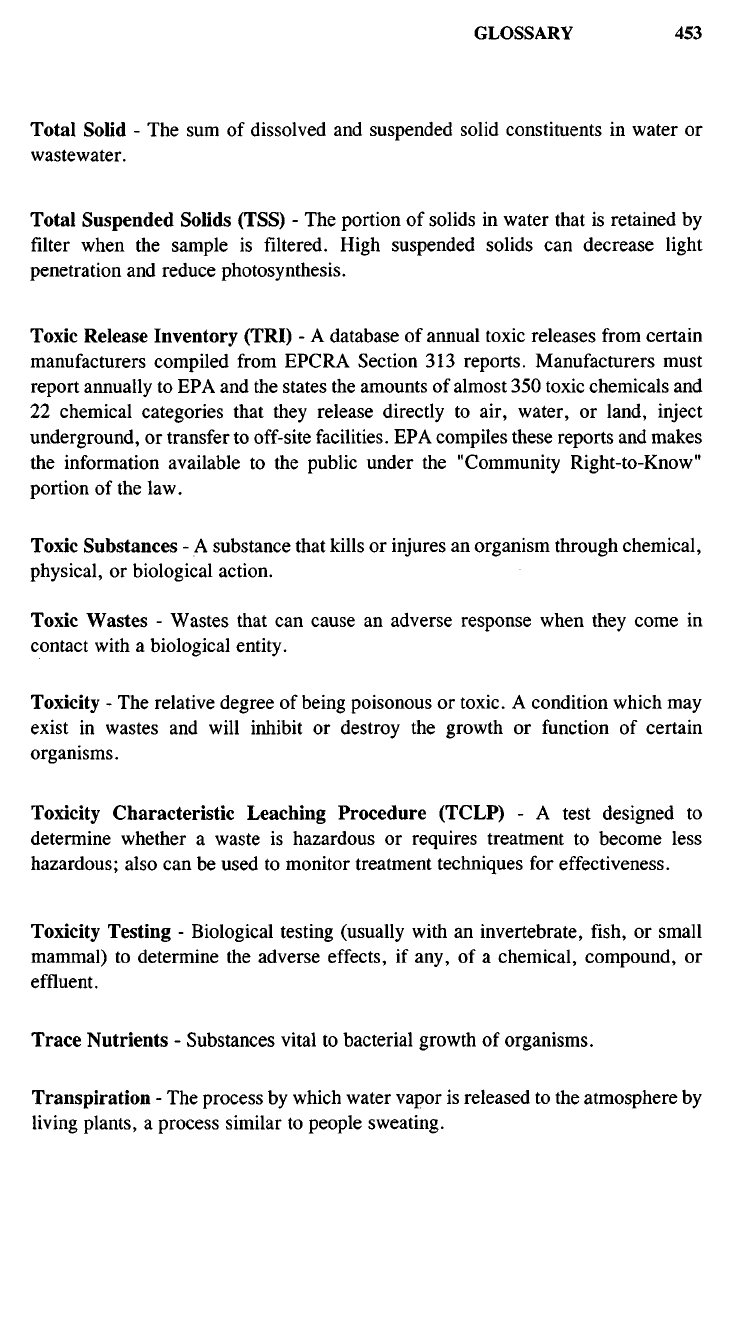
Total Solid - The sum of dissolved and suspended solid constituents in water or
wastewater.
Total Suspended Solids (TSS) - The portion of solids in water that is retained by
filter when the sample is filtered. High suspended solids can decrease light
penetration and reduce photosynthesis.
Toxic Release Inventory (TRI) - A database of annual toxic releases from certain
manufacturers compiled from EPCRA Section 313 reports. Manufacturers must
report annually to EPA and the states the amounts of almost 350 toxic chemicals and
22 chemical categories that they release directly to air, water, or land, inject
underground, or transfer to off-site facilities. EPA compiles these reports and makes
the information available to the public under the "Community Right-to-Know"
portion of the law.
Toxic Substances - A substance that kills or injures an organism through chemical,
physical, or biological action.
Toxic Wastes - Wastes that can cause an adverse response when they come in
contact with a biological entity.
Toxicity - The relative degree of being poisonous or toxic. A condition which may
exist in wastes and will inhibit or destroy the growth or function of certain
organisms.
Toxicity Characteristic Leaching Procedure (TCLP) - A test designed to
determine whether a waste is hazardous or requires treatment to become less
hazardous; also can be used to monitor treatment techniques for effectiveness.
Toxicity Testing - Biological testing (usually with an invertebrate, fish, or small
mammal) to determine the adverse effects, if any, of a chemical, compound, or
effluent.
Trace Nutrients - Substances vital to bacterial growth of organisms.
Transpiration - The process by which water vapor is released to the atmosphere by
living plants, a process similar to people sweating.

Trap - (1) A device used to prevent a material flowing or carried through a conduit
from reversing its direction of flow or movement, or from passing a given point. (2)
A device to prevent the escape of air from sewers through a plumbing fixture or
catch basin.
Treatment Methodologies - There are many specific ways of treating sewage to
render it safe to human health and the environment.
Treatment, Storage, and Disposal Facility (TSD) - Refers to any facility which
treats,
stores, or disposes of hazardous wastes.
Trickling Filter - A support medium for bacterial growth, usually a bed of rocks or
stones. The sewage is trickled over the bed so the bacteria can break down the
organic wastes. The bacteria collect on the stones through repeated use of the filter.
Trisodium Phosphate (Na
3
PO
4
) - Trisodium phosphate has the property of
softening water by precipitating metallic ions, as a gelatinous precipitate. It can also
help in dispersing soil and in the saponification of fatty acids. It can cocrystallize
with sodium hypochlorite (NaOCI), which then has the added advantage of being a
bleaching agent.
Trough - A structure, typically with a length several times its transverse
dimensions, used to hold or transport water or other liquids.
TSS - Total suspended solids.
Tube Settler - A series of tubes approximately 0.5 cm (2 in.) in diameter, placed in
a sedimentation tank to improve the solids removal efficiency.
Turbidimeter - An instrument for measurement of turbidity in which a standard
suspension is used for reference.
Turbidity - (1) A condition in water or waste water caused by the presence of
suspended matter and resulting in the scattering and absorption of light. (2) Any
suspended solids imparting a visible haze or cloudiness to water that can be removed
by filtration. (3) An analytical quantity typically reported in turbidity units
determined by measurements of light scattering.
Turbulence - (1) The fluid property that is characterized by irregular variation in
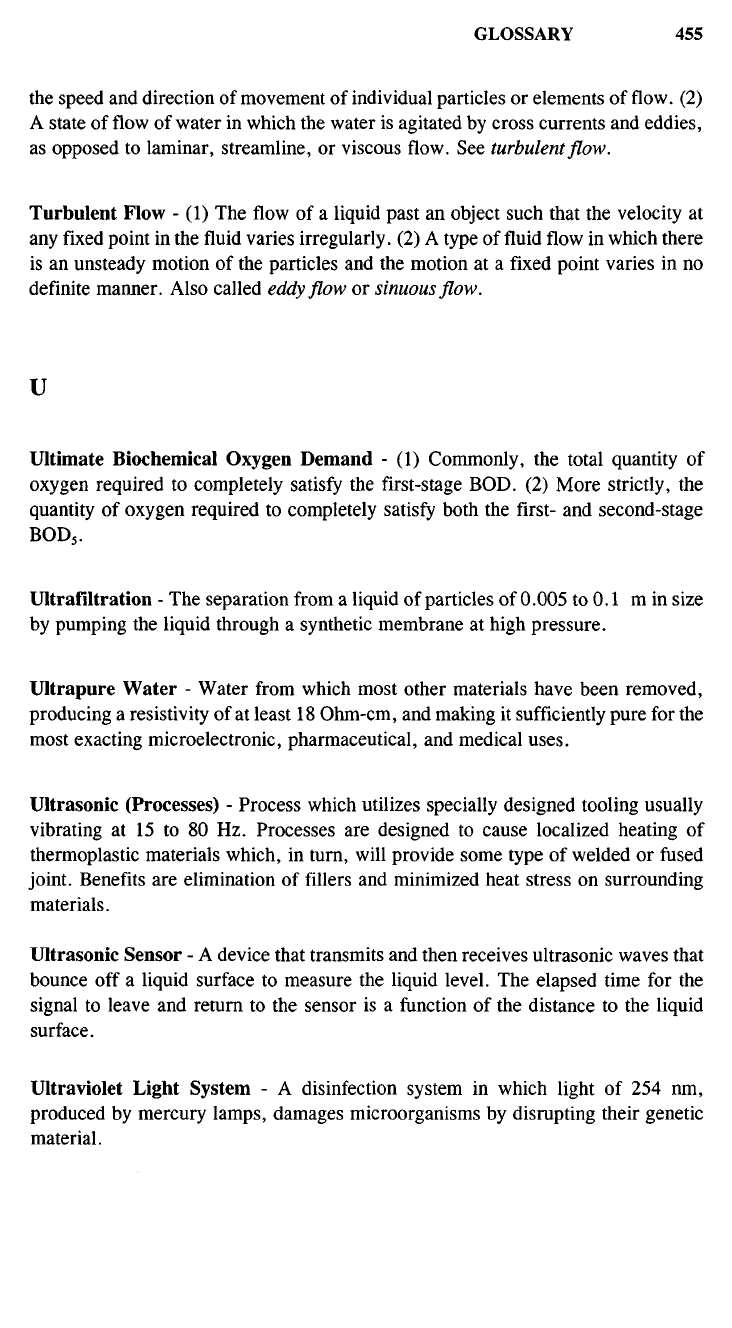
the speed and direction of movement of individual particles or elements of flow. (2)
A state of flow of water in which the water is agitated by cross currents and eddies,
as opposed to laminar, streamline, or viscous flow. See turbulent flow.
Turbulent Flow - (1) The flow of a liquid past an object such that the velocity at
any fixed point in the fluid varies irregularly. (2) A type of fluid flow in which there
is an unsteady motion of the particles and the motion at a fixed point varies in no
definite manner. Also called eddy flow or sinuous flow.
U
Ultimate Biochemical Oxygen Demand - (1) Commonly, the total quantity of
oxygen required to completely satisfy the first-stage BOD. (2) More strictly, the
quantity of oxygen required to completely satisfy both the first- and second-stage
BOD
5
.
Ultrafiltration - The separation from a liquid of particles of 0.005 to 0.1 m in size
by pumping the liquid through a synthetic membrane at high pressure.
Ultrapure Water - Water from which most other materials have been removed,
producing a resistivity of at least 18 Ohm-cm, and making it sufficiently pure for the
most exacting microelectronic, pharmaceutical, and medical uses.
Ultrasonic (Processes) - Process which utilizes specially designed tooling usually
vibrating at 15 to 80 Hz. Processes are designed to cause localized heating of
thermoplastic materials which, in turn, will provide some type of welded or fused
joint. Benefits are elimination of fillers and minimized heat stress on surrounding
materials.
Ultrasonic Sensor - A device that transmits and then receives ultrasonic waves that
bounce off a liquid surface to measure the liquid level. The elapsed time for the
signal to leave and return to the sensor is a function of the distance to the liquid
surface.
Ultraviolet Light System - A disinfection system in which light of 254 run,
produced by mercury lamps, damages microorganisms by disrupting their genetic
material.

Ultraviolet Treatment - In UV treatment the clear effluent resulting following
primary and secondary treatment is passed through transparent tubes and irradiated
with powerful UV light. If treatment is fully efficient, the remaining viruses and
bacteria can be killed to give an output that could virtually be drunk, even the
undiluted output straight from the effluent pipe. This method is quite one of the very
best methods possible and is much to be recommended. Unfortunately, it does not
sterilize the sludge, as the UV is unable to penetrate the turbidity.
Underdrain - A drain that carries away groundwater or the drainage from prepared
beds to which water or waste water has been applied.
Underground Injection Control (UIC) - A program under the Safe Drinking Water
Act that regulates the use of wells to pump fluids underground.
Underground Storage Tank (UST) - A tank and any underground piping connected
to the tank that has 10% or more of its volume (including pipe volume) beneath the
surface of the ground. USTs are designed to hold gasoline, other petroleum
products, and hazardous materials.
Unicellular - Single-celled organisms, such as bacteria.
Universal Joint - A joint or coupling that permits limited motion in any direction
and used to transmit rotary motion between shafts that are not collinear.
Universal Motor - An electric motor that is capable of running on alternating
current or direct current.
Unsteady Nonuniform Flow - Flow in which the velocity and the quantity of water
flowing per unit time at every point along the conduit varies with respect to time and
position.
Upflow - Term used to describe treatment units in which flow enters at the bottom
and exits at the top.
Upflow Clarifier - A treatment unit in which liquid containing suspended solids is
passed upward through a blanket of settling sludge. Mixing, flocculation, and solids
removal are all accomplished in the same unit.
Upflow Coagulation - Coagulation achieved by passing liquid, to which coagulating
chemicals may have been added, upward through a blanket of settling sludge.
